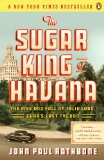Summary | Excerpt | Reviews | Beyond the Book | Readalikes | Genres & Themes | Author Bio

Critics' Opinion:
Readers' Opinion:
First Published:
Aug 2010, 320 pages
Paperback:
Jul 2011, 320 pages
 Book Reviewed by:
Book Reviewed by:
Elena Spagnolie
Buy This Book
INTRODUCTION
Cuba has known many rich men since Christopher Columbus first introduced sugarcane to the island. At the start of the twentieth century, one Cuban sugar baron tiled the floors of his Havana palace with Italian marble bedded down in sand imported from the Nile.
Tomás Terry, the most successful sugar planter of Cuba's colonial years, left $25 million on his death in 1886 - not bad considering that the then richest man in the world, William Backhouse Astor, left just $50 million.
Yet Cuba does not have to look back a century or more to find extreme riches. In Havana today to have Croesus-like wealth is referred to as serrico como un Julio Lobo - to be as rich as a Julio Lobo. After almost five decades of communism, Lobo's fabled wealth has become folkloric, and he has become emblematic of a way of life that existed in Havana before the dictator Fulgencio Batista fled the island on New Year's Eve 1958. Julio Lobo was the richest man in Cuba before Castro's revolution did away with such things.
Every Cuban schoolchild knows Columbus's description of the island as being "more beautiful than any I have ever seen"; it is Cuba's first exaggeration. Yet the island has also suffered a commensurately cruel history, like so many beautiful tropical places. Lobo was born in 1898, the year that Cuba won independence after thirty years of fighting against Spain, and he left the country in 1960, two years after Castro's guerrillas came down from the hills. So his life tightly frames the sixty-odd years of the Cuban Republic. In his heyday, Lobo was known as the King of Sugar, not just of Havana but of the world, with an estimated personal fortune of $200 million, about $5 billion in today's dollars. Yet he was also a financier of such talent that Castro's government, which was Communist, asked Lobo, a full-blooded capitalist, to work for them after the revolution had begun. So Lobo captures the period's contradictions too.
I had been fascinated by those elegant, decadent, and whirligig years all my life. The curiosity was an inevitable outgrowth of my mother's exile. She was born in Havana and raised into a conventional world as a child of the Cuban haute bourgeoisie. Her father owned a department store in the center of town; her grande dame mother presided over the home. Her parents mingled in the same world as Lobo's, and my mother was a close friend of his younger daughter. Years later, when I was a child and couldn't sleep, my mother would stroke my hair and murmur descriptions of her life in Cuba with its balmy Caribbean beaches until I closed my eyes. The props for her stories of an almost dreamlike prerevolutionary life were the photograph albums that she kept on a bottom bookshelf in our living room in London. They had ragged brown leather spines, which creaked when you opened them. The stiff black pages inside were separated by tissue paper, which crackled as you turned them. Some of the photographs had slipped their bindings and stuck together. Then you could only glimpse croppings of a disappeared world: an empty table at a cocktail party, the back of someone's head, a man's ankle disappearing into a polished black shoe on a marble step. But most of the photographs had survived intact.
There she is in one faded polychrome, seventeen years old, beaming, dressed casually, sitting cross-legged on a wall, her loafers tucked under her shins. A later photograph, this time in black-and-white, shows her standing next to her first boyfriend. The handwritten caption underneath anticipates later boyfriends and later pages; Victor y Yo, Victor and I, soon becomes Antonio y Yo, and then Walter y Yo - the characteristic concerns of a Cuban debutante. One sequence of photographs shows her uncharacteristically demure in a white ball dress, walking down a spiral staircase at the Havana Country Club during a fashion gala. Turn the page, carefully, and there she is again, this time performing an elegant arabesque while ice-skating at Havana's Blanquita Theater on First Avenue and Ninth Street, since renamed the Karl Marx Theater. Another shows her with a group of friends standing in the shallow end of a swimming pool, cocktails in their hands, all laughing. It looks like a scene of bourgeois American life in the 1950s, perhaps in Connecticut. Only it is a photograph of a swimming pool at one of Julio Lobo's many estates outside Havana where my mother sometimes stayed. It is also the same pool that Lobo supposedly filled with perfume so that Esther Williams, the Hollywood starlet of Bathing Beauty, could practice her swimming routines when she visited the island. Such are the legends from which revolutions are made, and then justified.
Excerpted from The Sugar King of Havana by John Paul Rathbone. Reprinted by arrangement with The Penguin Press, a member of Penguin Group (USA), Inc. Copyright (c) John Paul Rathbone, 2010.





The House on Biscayne Bay
by Chanel Cleeton
As death stalks a gothic mansion in Miami, the lives of two women intertwine as the past and present collide.

The Flower Sisters
by Michelle Collins Anderson
From the new Fannie Flagg of the Ozarks, a richly-woven story of family, forgiveness, and reinvention.

The Funeral Cryer by Wenyan Lu
Debut novelist Wenyan Lu brings us this witty yet profound story about one woman's midlife reawakening in contemporary rural China.
Your guide toexceptional books
BookBrowse seeks out and recommends the best in contemporary fiction and nonfiction—books that not only engage and entertain but also deepen our understanding of ourselves and the world around us.